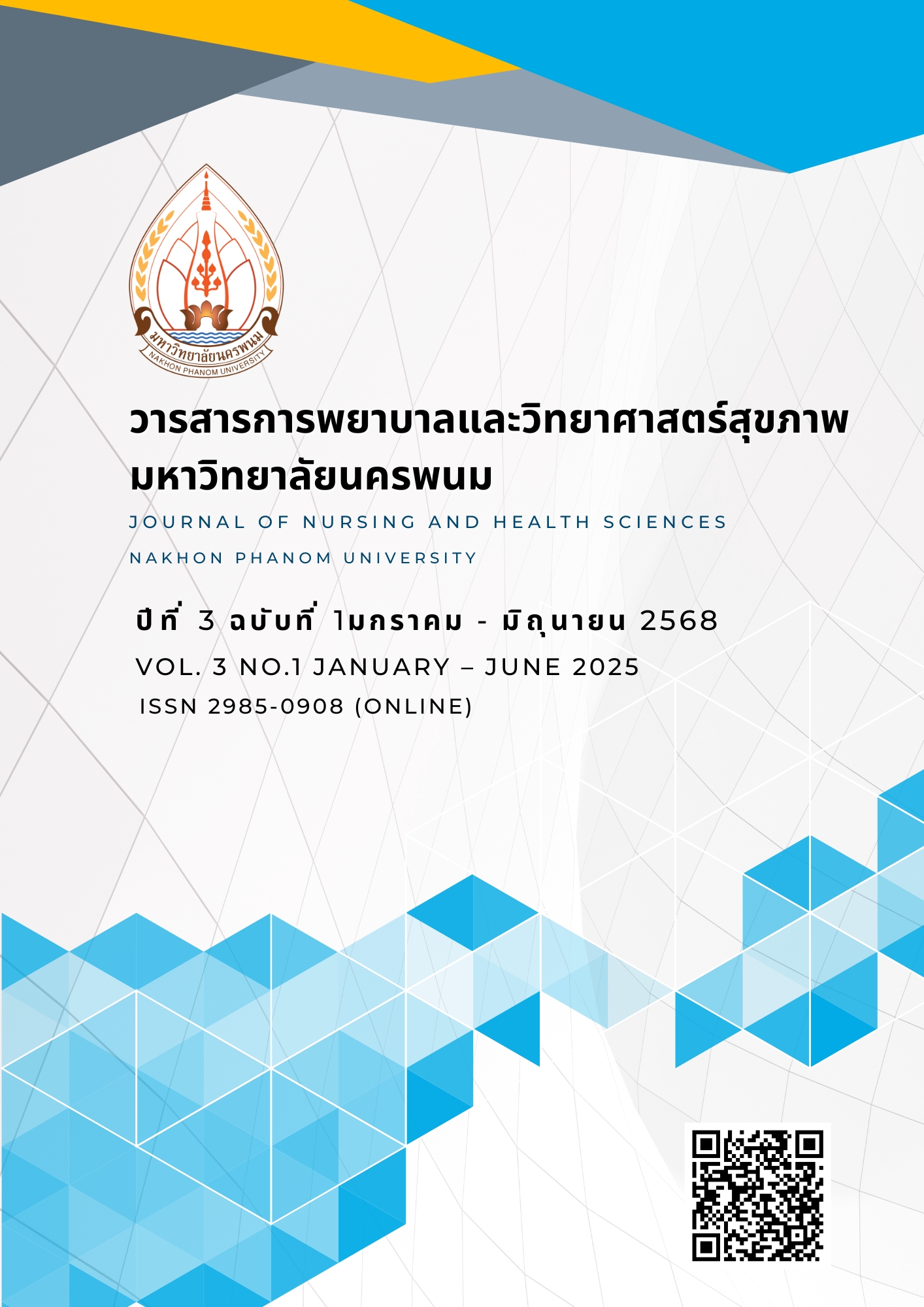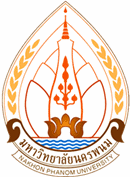ผลของโปรแกรมการส่งเสริมพฤติกรรมการตรวจคัดกรองมะเร็งปากมดลูก ของสตรีกลุ่มเสี่ยง โรงพยาบาลสกลนคร
The Effects of a Program to Promote Cervical Cancer Screening Behaviors among At-Risk Women at Sakon Nakhon Hospital
คำสำคัญ:
มะเร็งปากมดลูก, การตรวจคัดกรอง, สตรีกลุ่มเสี่ยงบทคัดย่อ
การวิจัยนี้ใช้ระเบียบวิธีกึ่งทดลอง แบบกลุ่มเดียววัดผลก่อนและหลังทำการทดลองเพื่อ 1 ) เปรียบเทียบคะแนนการรับรู้เกี่ยวกับมะเร็งปากมดลูกและพฤติกรรมการมาตรวจคัดกรองมะเร็งปากมดลูก ของสตรีกลุ่มเสี่ยง โรงพยาบาลสกลนคร 2) ศึกษาระดับความพึงใจของสตรีกลุ่มเสี่ยง โรงพยาบาลสกลนคร หลังได้รับโปรแกรมการส่งเสริมพฤติกรรมการมาตรวจคัดกรองมะเร็งปากมดลูก กลุ่มตัวอย่างเป็นสตรีกลุ่มเสี่ยงอายุ 30-60 ปี จำนวน 42 ราย เครื่องมือที่ใช้ในการวิจัยได้แก่ 1) โปรแกรมการส่งเสริมพฤติกรรมการมาตรวจคัดกรองมะเร็งปากมดลูก 2) แบบประเมินการรับรู้เกี่ยวกับมะเร็งปากมดลูกและพฤติกรรมการมาตรวจคัดกรองมะเร็งปากมดลูก
3) แบบประเมินความพึงพอใจ ผ่านการหาความตรงเชิงเนื้อหาและการทดสอบความเชื่อมั่นโดยการหาค่าสัมประสิทธ์แอลฟาของครอนบาค ได้เท่ากับ .76 และ.77 ตามลำดับ วิเคราะห์ข้อมูลเปรียบเทียบค่าเฉลี่ยโดยใช้สถิติ Paired t-test พบว่า
- สตรีกลุ่มเสี่ยงมีคะแนนเฉลี่ยการรับรู้เกี่ยวกับโรคมะเร็งปากมดลูกและพฤติกรรมการมาตรวจคัดกรองมะเร็งปากมดลูก เพิ่มขึ้นอย่างมีนัยสำคัญทางสถิติ (p<0.001) ก่อนได้รับโปรแกรมคะแนนอยู่ในระดับปานกลาง ( = 2.23 SD.= .51) และหลังได้รับโปรแกรมคะแนนอยู่ในระดับมาก ( = 2.60 SD. = .35) และพบว่าสตรีกลุ่มเสี่ยงมาตรวจคัดกรองมะเร็งปากมดลูกหลังทดลอง 1 เดือนทุกคน
- คะแนนเฉลี่ยความพึงพอใจของสตรีกลุ่มเสี่ยงต่อโปรแกรมส่งเสริมพฤติกรรมการตรวจคัดกรองมะเร็งปากมดลูกอยู่ในระดับมาก ( = 2.98 SD.= .037)
ดังนั้นจึงควรสนับสนุนให้นำโปรแกรมส่งเสริมพฤติกรรมการตรวจคัดกรองมะเร็งปากมดลูกไปใช้อย่างต่อเนื่องกับสตรีกลุ่มเสี่ยงอื่นๆ ที่อยู่ในเขตความรับผิดชอบ เพื่อให้การตรวจคัดกรองมะเร็งปากมดลูกครอบคลุมตามเกณฑ์ของกระทรวงสาธารณสุข
เอกสารอ้างอิง
UNFPA. Cervical Cancer Elimination in Asia-Pacific: Country Reviews & Roadmaps for Action. 2020. [Online] [cited 2023 Jun 26] Available from: https://asiapacific.unfpa.org/en/cervical-cancer-elimination-asia-pacific-country-reviews-roadmaps-action
Singh, D, et al. Global estimates of incidence and mortality of cervical cancer in 2020: a baseline analysis of the WHO Global Cervical Cancer Elimination Initiative. The Lancet Global Health. 2023, 11(2), e197 - e206.
วีรวุฒิ อิ่มสำราญ. กรมการแพทย์ เผยหญิงไทยป่วยมะเร็งปากมดลูกปีละ 5 พัน เสียชีวิตวันละ 6 คน. 2024. [Online] Available from: https://www.hfocus.org/content/2024/01/29624.
Bangkok Hospital. Thai women found dead from "Cervical cancer" 8-10 cases per day. [Online] Available from: https://www.pptvhd36.com/health/care/151. 2022.
Chaiyos Thirapokavong. มะเร็งปากมดลูก. [Online] Available from: https://www.si.mahidol.ac.th/sidoctor/e-pl/articledetail.asp?id=943. 2021.
Irene Ruangkachorn. มะเร็งปากมดลูก. Bangkok: Department of Obstetrics and Gynecology, Faculty of Medicine, Siriraj Hospital, Mahidol University; 2018.
Sarwar A, et al. Novel benchmark database of digitized and calibrated cervical cells for artificial intelligence based screening of cervical cancer. Cerv Cancer. 2016; 1:105.
Abate SM. Trends of cervical cancer in Ethiopia. Cerv Cancer. 2015; 1:103.
AbdAllah, et al. Awareness and attitudes of nursing students towards prevention of cervical cancer. Cerv Cancer. 2016; 1:107.
วสันต์ ลีนะสมิต, วัชระ เอี่ยมรัศมี, ชนิดา เกษประดิษฐ์ และกอบกุล ไพศาลอัชพงษ์. การป้องกัน
มะเร็งปากมดลูกในสภาวะทรัพยากรจำกัด. (พิมพ์ครั้งที่ 4). นนทบุรี: สำนักอนามัยการเจริญพันธุ์ กรมอนามัย กระทรวงสาธารณสุข. 2558.
พรรณี ปิ่นนาค. เหตุผลและปัจจัยของการไม่ไปรับการตรวจคัดกรองมะเร็งปากมดลูก: กรณีศึกษา
สตรีอายุ 30-60 ปี ในตำบลนาโพธิ์ อำเภอสวี จังหวัดชุมพร. วารสารวิจัยและนวัตกรรมทางสุขภาพ. 2563; 3(1), 118-131.
ภูนรินทร์ สีกุด, มะลิวัลย์ บางนิ่มน้อย และชาลินี มานะยิ่ง. ปัจจัยที่มีความสัมพันธ์กับการมารับ
บริการตรวจคัดกรองมะเร็งปากมดลูกของสตรีกลุ่มเสี่ยง ตำบลบ้านใหม่ อำเภอเมือง จังหวัดนครราชสีมา. วารสารสาธารณสุขมูลฐาน ภาคตะวันออกเฉียงเหนือ. 2564; 36(1), 37-47.
ชนกพร ปี้บ้านท่า. ผลของโปรแกรมส่งเสริมพฤติกรรมการมารับบริการตรวจคัดกรองมะเร็งปากมดลูกของสตรีอายุ 30-60 ปี โรงพยาบาลวิภาวดี อำเภอวิภาวดี จังหวัดสุราษฎร์ธานี. วารสารวิจัยและนวัตกรรมทางสุขภาพ. 2565; 3(1), 101-114.
บุษบา อภัยพิม, รุ่งรัตน์ ศรีสุริยเวศน์, และสมสมัย รัตนกรีฑากุล. ผลของโปรแกรมส่งเสริมการคัด
กรองมะเร็งปากมดลูกต่อพฤติกรรมการคัดกรองมะเร็งปากมดลูกในอาสาสมัครสาธารณสุขประจำหมู่บ้าน. วารสารการพัฒนาสุขภาพชุมชน มหาวิทยาลัยขอนแก่น. 2562; 7(3), 381-401.
สุวิมล สอนศรี, วาริณี เอี่ยมสวัสดิกุล, และชื่นจิตร โพธิศัพท์สุข. ผลของโปรแกรมส่งเสริมการตรวจคัดกรองมะเร็งปากมดลูกสตรีกลุ่มเสี่ยง อำเภอเสลภูมิ จังหวัดร้อยเอ็ด. วารสารพยาบาล. 2564;70(3), 11-19.
Strecher VJ, Rosenstock IM. Social learning theory and health belief model. Health Educ Q. 1996; 15(2):75-138.
Bartz AE. Basic statistical concepts. 4th ed. New Jersey: Prentice Hall; 1999.
กานดา ศรีตระกูล และพิษณุรักษ์ กันทวี. ผลของโปรแกรมการรับรู้ความเชื่อด้านสุขภาพต่อระดับ
ทัศนคติในสตรีที่เข้ารับการตรวจคัดกรองมะเร็งปากมดลูก ตำบลท่าข้าวเปลือก อำเภอแม่จัน จังหวัดเชียงราย. เชียงรายเวชสาร. 2560; 9(1), 123-132.




